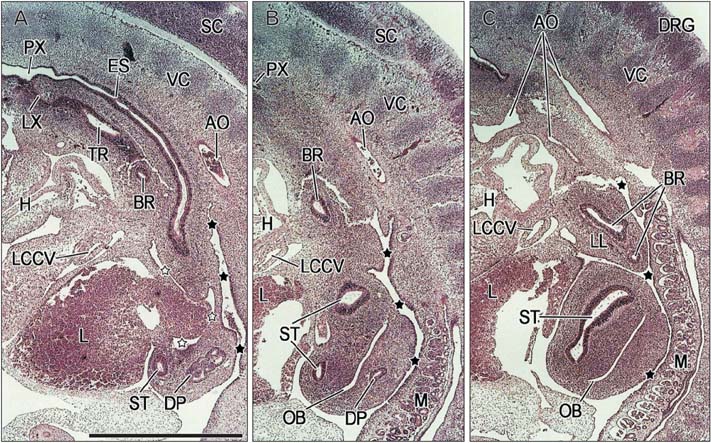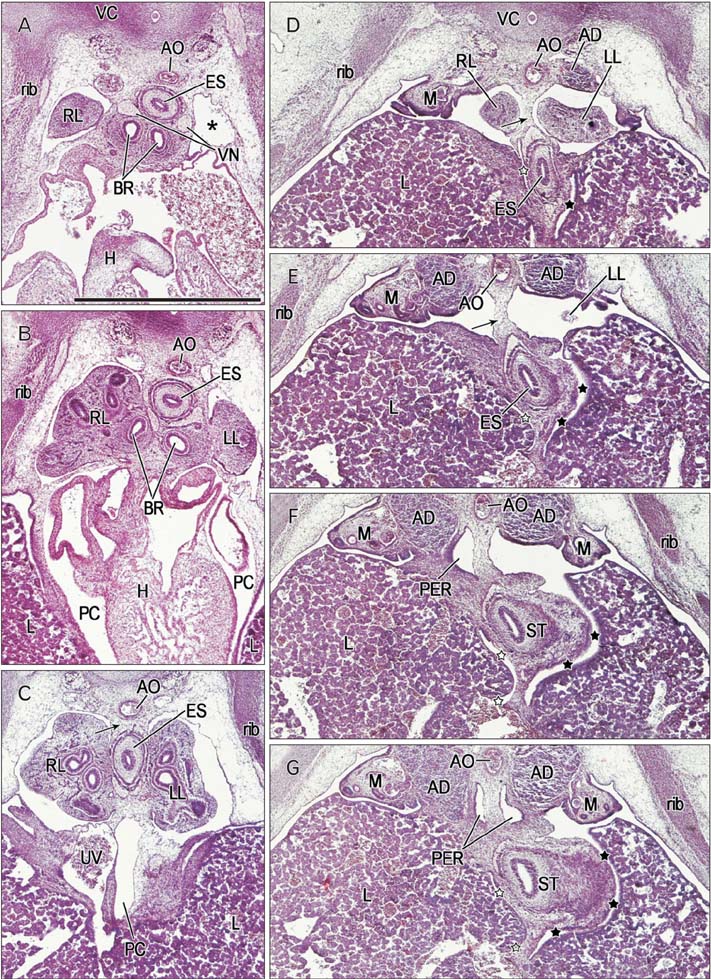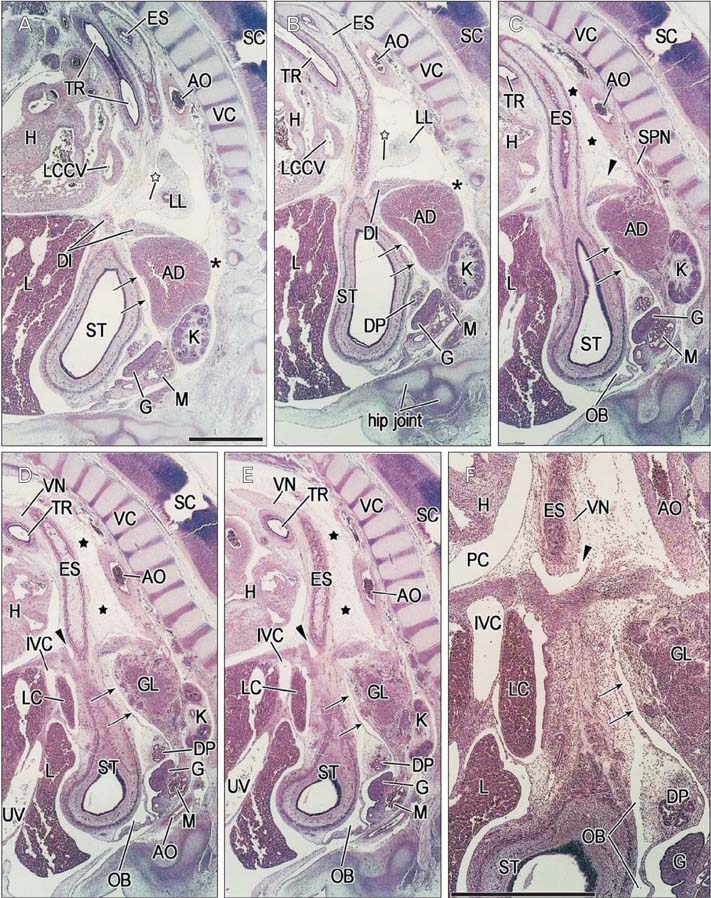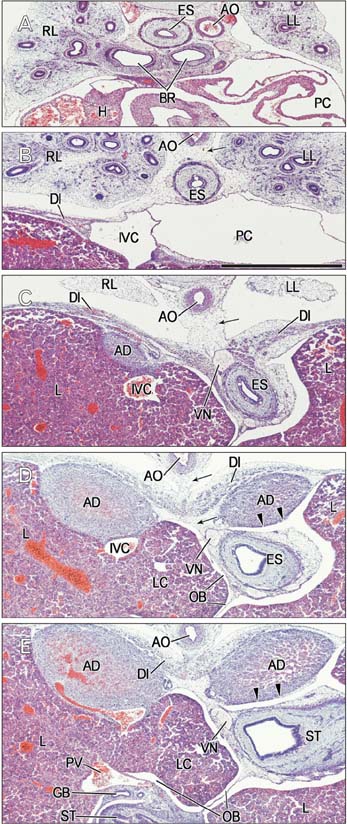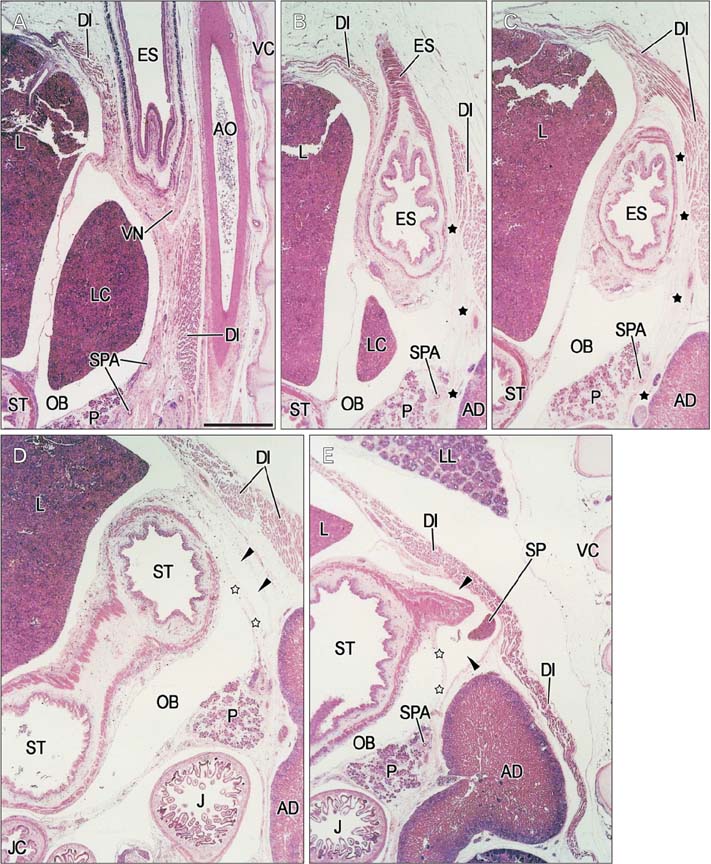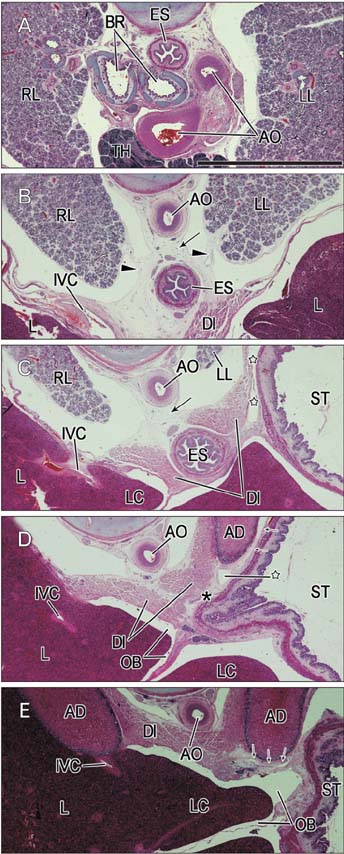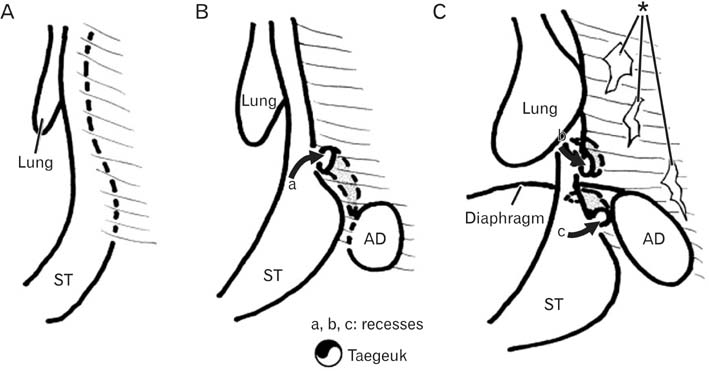Anat Cell Biol.
2014 Dec;47(4):227-235. 10.5115/acb.2014.47.4.227.
Mesoesophagus and other fascial structures of the abdominal and lower thoracic esophagus: a histological study using human embryos and fetuses
- Affiliations
-
- 1Department of Surgery, Daejeon Sun Hospital, Daejeon, Korea.
- 2Department of Anatomy, Chonbuk National University Medical School, Jeonju, Korea. 407kk@hanmail.net
- 3Department of Surgery and Biomedical Research Institute, Chonbuk National University Hospital, Jeonju, Korea.
- 4Institute of Embryology, Universitad Complutense, Madrid, Spain.
- 5Division of Internal Medicine, Iwamizawa Asuka Hospital, Iwamizawa, Japan.
- KMID: 1882601
- DOI: http://doi.org/10.5115/acb.2014.47.4.227
Abstract
- A term "mesoesophagus" has been often used by surgeons, but the morphology was not described well. To better understand the structures attaching the human abdominal and lower thoracic esophagus to the body wall, we examined serial or semiserial sections from 10 embryos and 9 fetuses. The esophagus was initially embedded in a large posterior mesenchymal tissue, which included the vertebral column and aorta. Below the tracheal bifurcation at the fifth week, the esophagus formed a mesentery-like structure, which we call the "mesoesophagus," that was sculpted by the enlarging lungs and pleural cavity. The pneumatoenteric recess of the pleuroperitoneal canal was observed in the lowest part of the mesoesophagus. At the seventh week, the mesoesophagus was divided into the upper long and lower short parts by the diaphragm. Near the esophageal hiatus, the pleural cavity provided 1 or 2 recesses in the upper side, while the fetal adrenal gland in the left side was attached to the lower side of the mesoesophagus. At the 10th and 18th week, the mesoesophagus remained along the lower thoracic esophagus, but the abdominal esophagus attached to the diaphragm instead of to the left adrenal. The mesoesophagus did not contain any blood vessels from the aorta and to the azygos vein. The posterior attachment of the abdominal esophagus seemed to develop to the major part of the phrenoesophageal membrane with modification from the increased mass of the left fetal adrenal. After postnatal degeneration of the fetal adrenal, the abdominal esophagus might again obtain a mesentery. Consequently, the mesoesophagus seemed to correspond to a small area containing the pulmonary ligament and aorta in adults.
MeSH Terms
Figure
Reference
-
1. Hamilton WJ, Mossman HW. Human embryology: prenatal development of form and function. 4th ed. Lodon: Williams & Wilkins;1978. p. 334–337.2. Hayashi S, Fukuzawa Y, Rodríguez-Vázquez JF, Cho BH, Verdugo-López S, Murakami G, Nakano T. Pleuroperitoneal canal closure and the fetal adrenal gland. Anat Rec (Hoboken). 2011; 294:633–644.3. Jin ZW, Nakamura T, Yu HC, Kimura W, Murakami G, Cho BH. Fetal anatomy of peripheral lymphatic vessels: a D2-40 immunohistochemical study using an 18-week human fetus (CRL 155 mm). J Anat. 2010; 216:671–682.4. Kanagasuntheram R. Development of the human lesser sac. J Anat. 1957; 91:188–206.5. Jin ZW, Cho BH, Murakami G, Fujimiya M, Kimura W, Yu HC. Fetal development of the retrohepatic inferior vena cava and accessory hepatic veins: Re-evaluation of the Alexander Barry's hypothesis. Clin Anat. 2010; 23:297–303.6. Yang JD, Ishikawa K, Hwang HP, Yu HC, Rodríguez-Vázquez JF, Murakami G, Cho BH. Morphology of the ligament of Treitz likely depends on its fetal topographical relationship with the left adrenal gland and liver caudate lobe as well as the developing lymphatic tissues: a histological study using human fetuses. Surg Radiol Anat. 2013; 35:25–38.7. Perlemuter L, Waligora J. Cahiers d'anatomie. Vol. 6. Thorax. 3rd ed. Paris: Masson;1976.8. Miyake N, Takeuchi H, Cho BH, Murakami G, Fujimiya M, Kitano H. Fetal anatomy of the lower cervical and upper thoracic fasciae with special reference to the prevertebral fascial structures including the suprapleural membrane. Clin Anat. 2011; 24:607–618.9. Boutelier P, Lefort R. Anatomic study of the abdominal mesoesophagus. Surgical deductions. J Chir (Paris). 1970; 100:371–384.10. Cho BH, Kimura W, Song CH, Fujimiya M, Murakami G. An investigation of the embryologic development of the fascia used as the basis for pancreaticoduodenal mobilization. J Hepatobiliary Pancreat Surg. 2009; 16:824–831.11. Hayashi S, Murakami G, Ohtsuka A, Itoh M, Nakano T, Fukuzawa Y. Connective tissue configuration in the human liver hilar region with special reference to the liver capsule and vascular sheath. J Hepatobiliary Pancreat Surg. 2008; 15:640–647.12. Yang JD, Ishikawa K, Hwang HP, Park DE, Song JS, Fujimiya M, Murakami G, Cho BH. Retropancreatic fascia is absent along the pancreas facing the superior mesenteric artery: a histological study using elderly donated cadavers. Surg Radiol Anat. 2013; 35:403–410.13. Watanabe Y, Lister J. Development of the human fetal phrenoesophageal membrane and its role in the anti-reflux mechanism. Surg Today. 1993; 23:722–727.14. Kinoshita H, Umezawa T, Omine Y, Kasahara M, Rodríguez-Vázquez JF, Murakami G, Abe S. Distribution of elastic fibers in the head and neck: a histological study using late-stage human fetuses. Anat Cell Biol. 2013; 46:39–48.15. St Peter SD, Barnhart DC, Ostlie DJ, Tsao K, Leys CM, Sharp SW, Bartle D, Morgan T, Harmon CM, Georgeson KE, Holcomb GW 3rd. Minimal vs extensive esophageal mobilization during laparoscopic fundoplication: a prospective randomized trial. J Pediatr Surg. 2011; 46:163–168.16. Kwok H, Mariz Y, Al-Ali S, Windsor JA. Phrenoesophageal ligament re-visited. Clin Anat. 1999; 12:164–170.17. Apaydin N, Uz A, Evirgen O, Loukas M, Tubbs RS, Elhan A. The phrenico-esophageal ligament: an anatomical study. Surg Radiol Anat. 2008; 30:29–36.18. Nakajima F, Murakami G, Ohyama S, Horiguchi T, Sakakura Y, Yajima T, Hirata K. Potential fascial dome made by the upper leaf of the phreno-esophageal membrane. Okajimas Folia Anat Jpn. 2001; 77:201–209.19. Okabayashi T, Kobayashi M, Sucgimoto T, Ohara S, Okamoto K, Matsuura K, Araki K. Posterior gastric artery in angiograms and its surgical importance. Hepatogastroenterology. 2005; 52:298–301.20. Hwang SE, Cho BH, Hirai I, Kim HT, Kim JH, Fujimiya M, Murakami G, Kimura W. Topographical anatomy of Spiegel’s lobe and its adjacent organs in mid-term fetuses: its implication on the development of the lesser sac and adult morphology of the upper abdomen. Clin Anat. 2010; 23:712–719.
- Full Text Links
- Actions
-
Cited
- CITED
-
- Close
- Share
- Similar articles
-
- Intestinal Rotation, Luminal Obstruction and Recanalization in the Human Embryos and Fetuses
- Persistent right umbilical vein: a study using serial sections of human embryos and fetuses
- Histological Observations on Human Thyroids: 100 cases analysis of embryos and fetuses
- A Case of Intra-Abdominal Esophageal Duplication Cyst
- Development of the Shoulder Joint in Staged Human Embryos and Fetuses in Korean

